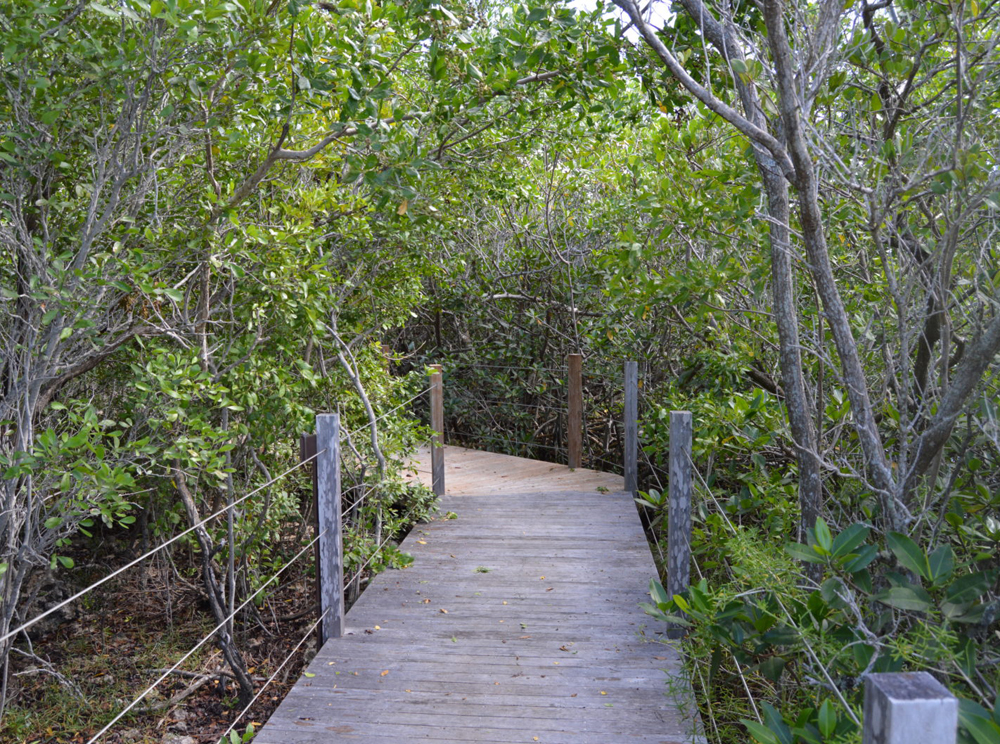Experience an in-depth sojourn in the subtropical Florida Keys & Key West, and you’re likely to discover some fascinating indigenous species in hidden, tucked-away gardens nestled throughout the 125-mile-long island chain.

Beautiful and colorful hibiscus can be found in many yards and gardens in the Florida Keys. (Photo by Carolan Ivey, Florida Keys Photo Adventure)
Hardy palms, tolerant of salt spray from the nearby Atlantic Ocean, sway in easy breezes. Other trees fringing the Keys landscape bear exotic names including gumbo limbo (sometimes referred to as the “tourist tree” because of its peeling red bark) and lignumvitae, with vivid blue or purple flowers and resin that can treat arthritis (yes, really!).
Some Keys plants shelter wildlife like the tiny, endangered native Key deer and marsh rabbit. Others such as sea oats, dwarf lantana and blue porterweed that attract butterflies provide colorful contrast to the Keys’ lush greenery.
So where can you explore the island chain’s environment and discover tree, plant and flower species?
Start in Key Largo, where the Gardens at Kona Kai Resort, overlooking Florida Bay and Everglades National Park, are nestled on the grounds of a boutique hotel: the 13-room Kona Kai Resort. The lush and lovely gardens, at 97802 Overseas Highway, feature over 250 documented tropical species.
In the Middle Keys, tropical woodlands called hammocks dot the landscape at Marathon’s Crane Point Hammock Museum & Nature Center, located at 5550 Overseas Highway. This unique site is home to the hardwood species lignumvitae, Jamaica dogwood and native thatch palms found nowhere else in the United States. The Florida Keys Land and Sea Trust preserves the 63.5-acre site — one of the Keys’ most sensitive environmental and archaeological attractions.

The Lower Keys’ Grimal Grove, a 2-acre farm and botanical garden, is home to rare tropical fruit trees including cacao, whose seeds are used to make cocoa and chocolate. (Photo courtesy of Grimal Grove)
Crane Point is named for preservationists and ardent horticulturists Frances and Mary Crane. From the late 1940s to the 1970s, the Cranes planted exotic flowering trees and shrubs. You’ll also find red, white and black mangroves and marsh pools on the property.
Travel farther south to Big Pine Key to explore Grimal Grove, lying just off the Overseas Highway at 258 Cunningham Lane.
This captivating 2-acre farm and botanical garden is the first agricultural venture of its kind in the Keys in the last 50 years.
Tropical fruit trees, herbs, greens and ornamentals are all grown on the site — and visitors can learn about the grove’s history of survival.
Sustainably grown products include blends of Grimal Grove Honey flavored with seasonal tropical fruit. Owner Patrick Garvey brings Grimal products to weekend farmer’s markets at several places on Big Pine Key and in Key West.
Just outside Key West at 5210 College Road lies the 15-acre Key West Tropical Forest & Botanical Garden — which features two of the Keys’ last remaining natural freshwater ponds and is a major migratory stop for South American neotropical birds.
Visitors can take self-guided and cell-phone tours that cover two wetland habitats and two 1.5-acre butterfly habitats with over 38 species. There’s also a waterfall, tropical plants, seasonal flowers, a lush palm canopy and a picnic pavilion.

Discover beautiful lignumvitae flowers at the Key West Tropical Forest & Botanical Garden. (Photo courtesy of the Key West Botanical Garden Society)
The garden was developed during the 1930s as a showplace for visitors by the U.S. Federal Emergency Relief Administration. These days it’s overseen by the Key West Botanical Garden Society Inc. and is a member of the American Public Gardens Association and Botanic Gardens Conservation International.
The Key West Garden Club at West Martello Tower, one of the island’s most tranquil locales, overlooks Higgs Beach and the Atlantic Ocean at 1100 Atlantic Blvd.
Listed on the National Register of Historic Places, West Martello Tower is a never-used Civil War–era fort marked by vaulted ceilings, gun mounts and a conservatory.
Today it’s a free visitor attraction whose weathered brick arches frame exotic orchids and bromeliads, rare and indigenous palms and plants, a peace garden and a stunning strangler fig tree that has grown over one of the arches.
And don’t miss the pitch apple, known as an “autograph tree” because traveling sailors used its thick, broad leaves as a natural “stationery” — scratching messages into the leaves with a sharp point.

